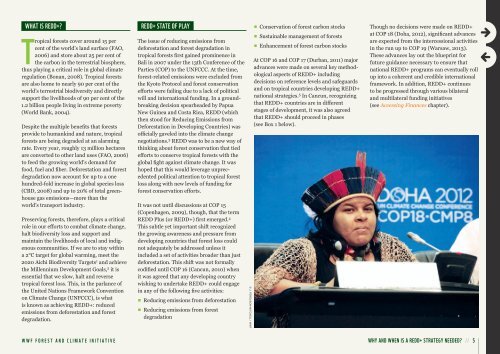WWF Guide to Building REDD+ Strategies
WWF Guide to Building REDD+ Strategies
WWF Guide to Building REDD+ Strategies
Create successful ePaper yourself
Turn your PDF publications into a flip-book with our unique Google optimized e-Paper software.
WHat iS Redd+?<br />
tropical forests cover around 15 per<br />
cent of the world’s land surface (FAO,<br />
2006) and s<strong>to</strong>re about 25 per cent of<br />
the carbon in the terrestrial biosphere,<br />
thus playing a critical role in global climate<br />
regulation (Bonan, 2008). Tropical forests<br />
are also home <strong>to</strong> nearly 90 per cent of the<br />
world’s terrestrial biodiversity and directly<br />
support the livelihoods of 90 per cent of the<br />
1.2 billion people living in extreme poverty<br />
(World Bank, 2004).<br />
Despite the multiple benefits that forests<br />
provide <strong>to</strong> humankind and nature, tropical<br />
forests are being degraded at an alarming<br />
rate. Every year, roughly 13 million hectares<br />
are converted <strong>to</strong> other land uses (FAO, 2006)<br />
<strong>to</strong> feed the growing world’s demand for<br />
food, fuel and fiber. Deforestation and forest<br />
degradation now account for up <strong>to</strong> a one<br />
hundred-fold increase in global species loss<br />
(CBD, 2008) and up <strong>to</strong> 20% of <strong>to</strong>tal greenhouse<br />
gas emissions—more than the<br />
world’s transport industry.<br />
Preserving forests, therefore, plays a critical<br />
role in our efforts <strong>to</strong> combat climate change,<br />
halt biodiversity loss and support and<br />
maintain the livelihoods of local and indigenous<br />
communities. If we are <strong>to</strong> stay within<br />
a 2°C target for global warming, meet the<br />
2020 Aichi Biodiversity Targets 1 and achieve<br />
the Millennium Development Goals, 2 it is<br />
essential that we slow, halt and reverse<br />
tropical forest loss. This, in the parlance of<br />
the United Nations Framework Convention<br />
on Climate Change (UNFCCC), is what<br />
is known as achieving <strong>REDD+</strong>: reduced<br />
emissions from deforestation and forest<br />
degradation.<br />
Redd+ State oF Play<br />
The issue of reducing emissions from<br />
deforestation and forest degradation in<br />
tropical forests first gained prominence in<br />
Bali in 2007 under the 13th Conference of the<br />
Parties (COP) <strong>to</strong> the UNFCCC. At the time,<br />
forest-related emissions were excluded from<br />
the Kyo<strong>to</strong> Pro<strong>to</strong>col and forest conservation<br />
efforts were failing due <strong>to</strong> a lack of political<br />
will and international funding. In a groundbreaking<br />
decision spearheaded by Papua<br />
New Guinea and Costa Rica, REDD (which<br />
then s<strong>to</strong>od for Reducing Emissions from<br />
Deforestation in Developing Countries) was<br />
officially gaveled in<strong>to</strong> the climate change<br />
negotiations. 3 REDD was <strong>to</strong> be a new way of<br />
thinking about forest conservation that tied<br />
efforts <strong>to</strong> conserve tropical forests with the<br />
global fight against climate change. It was<br />
hoped that this would leverage unprecedented<br />
political attention <strong>to</strong> tropical forest<br />
loss along with new levels of funding for<br />
forest conservation efforts.<br />
It was not until discussions at COP 15<br />
(Copenhagen, 2009), though, that the term<br />
REDD Plus (or <strong>REDD+</strong>) first emerged. 4<br />
This subtle yet important shift recognized<br />
the growing awareness and pressure from<br />
developing countries that forest loss could<br />
not adequately be addressed unless it<br />
included a set of activities broader than just<br />
deforestation. This shift was not formally<br />
codified until COP 16 (Cancun, 2010) when<br />
it was agreed that any developing country<br />
wishing <strong>to</strong> undertake <strong>REDD+</strong> could engage<br />
in any of the following five activities:<br />
n Reducing emissions from deforestation<br />
n Reducing emissions from forest<br />
degradation<br />
© J. FERGUSON-MITCHELL / <strong>WWF</strong><br />
n Conservation of forest carbon s<strong>to</strong>cks<br />
n Sustainable management of forests<br />
n Enhancement of forest carbon s<strong>to</strong>cks<br />
At COP 16 and COP 17 (Durban, 2011) major<br />
advances were made on several key methodological<br />
aspects of <strong>REDD+</strong> including<br />
decisions on reference levels and safeguards<br />
and on tropical countries developing <strong>REDD+</strong><br />
national strategies. 5 In Cancun, recognizing<br />
that <strong>REDD+</strong> countries are in different<br />
stages of development, it was also agreed<br />
that <strong>REDD+</strong> should proceed in phases<br />
(see Box 1 below).<br />
Though no decisions were made on <strong>REDD+</strong><br />
at COP 18 (Doha, 2012), significant advances<br />
are expected from the intercessional activities<br />
in the run up <strong>to</strong> COP 19 (Warsaw, 2013).<br />
These advances lay out the blueprint for<br />
future guidance necessary <strong>to</strong> ensure that<br />
national <strong>REDD+</strong> programs can eventually roll<br />
up in<strong>to</strong> a coherent and credible international<br />
framework. In addition, <strong>REDD+</strong> continues<br />
<strong>to</strong> be progressed through various bilateral<br />
and multilateral funding initiatives<br />
(see Accessing Finances chapter).<br />
<strong>WWF</strong> FOREST AND CLIMATE INITIATIVE WHy and WHen iS a Redd+ StRateGy needed? // 5

















